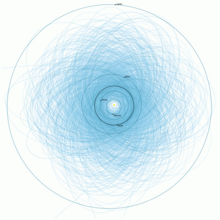Sentry (monitoring system)
Sentry is a highly automated impact prediction system operated by the JPL Center for NEO Studies (CNEOS) since 2002. It continually monitors the most current asteroid catalog for possibilities of future impact with Earth over the next 100+ years.[1] Whenever a potential impact is detected it will be analyzed and the results immediately published by the Near Earth Object Program.[1] However, several weeks of optical data are not enough to conclusively identify an impact years in the future.[2] By contrast, eliminating an entry on the risk page is a negative prediction; a prediction of where it will not be.[2] Scientists warn against worrying about the possibility of impact with an object based on only a few weeks of optical data that show a possible Earth encounter years from now.[2]
Sentry Risk Table

The Impact Risk page lists a number of lost objects that are, for all practical purposes, permanent residents of the risk page; their removal may depend upon a serendipitous rediscovery.[3] 1997 XR2 was serendipitously rediscovered in 2006 after being lost for more than 8 years. 2004 BX159 was determined to be a harmless main belt asteroid in 2014. Some objects on the Sentry Risk Table, such as 2000 SG344, might even be man-made.
2010 RF12 is the asteroid with greatest probability (5%) of impacting Earth, but is only ~7 meters in diameter. Numbered notable objects with observation arcs of several years include: (29075) 1950 DA, 99942 Apophis, 101955 Bennu, and (410777) 2009 FD.[1] Notable asteroids removed from Sentry in the last few years include (most recently removed listed first): 2017 XO2, 1994 WR12, 2007 VK184, 2013 BP73, 2008 CK70, 2013 TV135, 2011 BT15, 367943 Duende, and 2011 AG5.
The diameter of most near-Earth asteroids that have not been studied by radar or infrared can generally only be estimated within about a factor of 2 based on the asteroid's absolute magnitude (H).[1] Their mass, consequently, is uncertain by about a factor of 10. For near-Earth asteroids without a well-determined diameter, Sentry assumes a generic albedo of 0.15. More than two dozen known asteroids have higher than a one in a million chance of impacting into Earth within the next 100 years.[4]
In August 2013, the Sentry Risk Table started using planetary ephemeris (DE431) for all NEO orbit determinations.[5] DE431 (JPL small-body perturber ephemeris: SB431-BIG16) better models the gravitational perturbations of the planets and includes the 16 most massive main-belt asteroids.[5]
JPL launched major changes to the website in February 2017 and re-directed the classic page on 10 April 2017.
As of January 2018[update] there are roughly 818 near-Earth asteroids listed on the risk table[1] and roughly 2097 asteroids have been removed from the risk table since it launched in 2002.[6]
See Also
References
- ^ a b c d e "Sentry Risk Table". NASA/JPL Near-Earth Object Program Office. Retrieved 2017-04-13.
- ^ a b c Jon Giorgini (30 July 2002). "Understanding Risk Pages". Columbine, Inc. (hohmanntransfer). Retrieved 2011-11-21.
- ^ "IMPACT RISK ASSESSMENT: AN INTRODUCTION". NASA/JPL Near-Earth Object Program Office. 31 Aug 2005. Retrieved 2011-10-14.
- ^ Donald K. Yeomans (9 February 2013). "Beware of Errant Asteroids". New York Times. Retrieved 10 February 2013.
{{cite web}}: External link in|author= - ^ a b "Sentry Notes". NASA/JPL Near-Earth Object Program Office. 2013-08-12. Retrieved 2017-04-13.
- ^ "Removed Objects". NASA/JPL Near-Earth Object Program Office. Archived from the original on 2017-02-25. Retrieved 2017-02-16.
{{cite web}}: Unknown parameter|deadurl=ignored (|url-status=suggested) (help)
